I Dream Of Cheeses
Cheese dream sandwiches, according to the Wikipedia article, are “an open-faced version of the American grilled cheese sandwich” consisting of “a slice of bread, topped with American cheese and broiled until the cheese puffs up and browns.” James Beard, the “Dean of American Cuisine” throughout the latter half of the 20th century, described them with a bit more flourish. In a series of articles he wrote during the 1970s for American Airlines’ in-flight magazine American Way, later collected and published in the book “James Beard’s Simple Foods,” he described them like this:

“A slice of tomato on bread, covered with American cheese which was melted under the broiler and then graced with crisp bacon.” A simple, delicious, and highly savory open-faced sandwich.
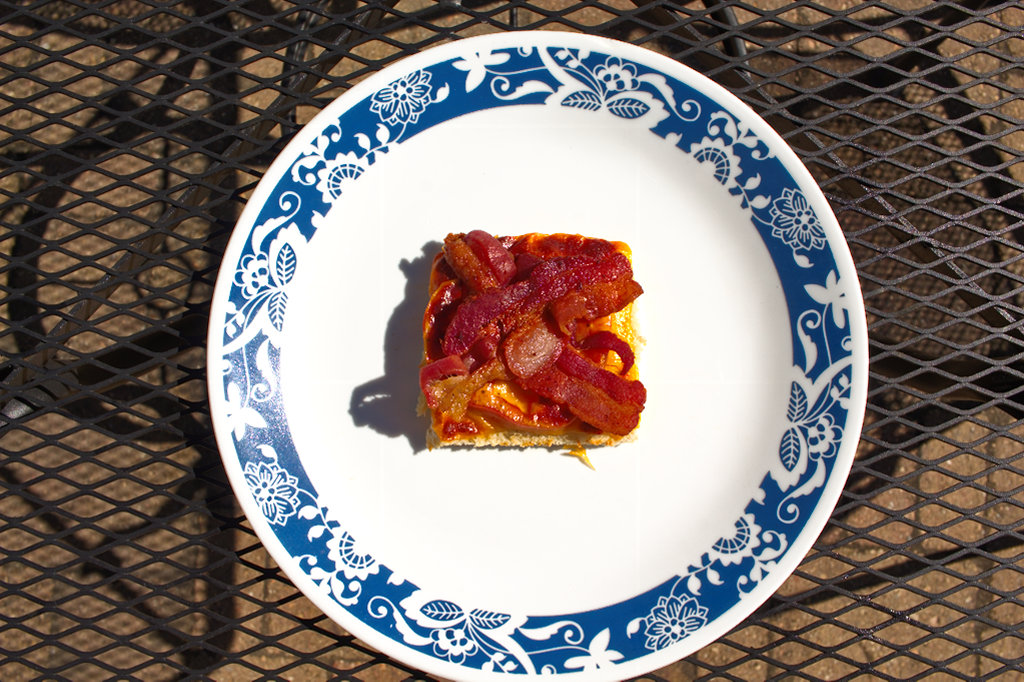
In another article on Bacon entitled “The Friendliest Meat”–this one is online and you can read it yourself–he described the sandwich more prosaically as “a great combination of Cheddar cheese, bacon, and sliced tomato.”
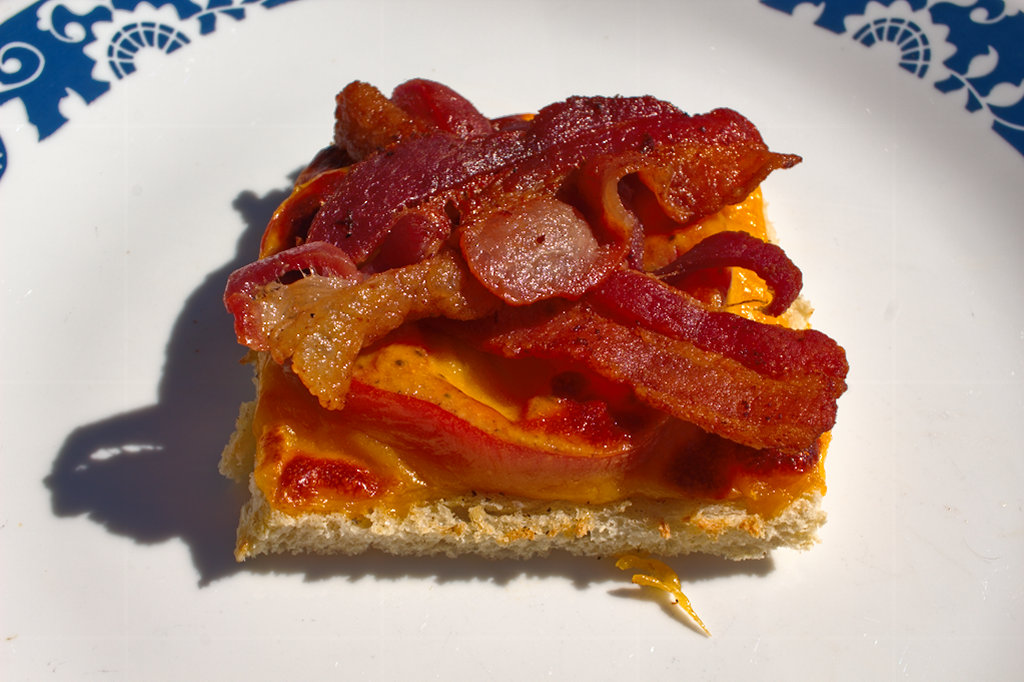
In this case he doesn’t describe the method of cooking but I presume it to be the same–broiled to melt and brown the cheese, topped with cooked bacon. The melted cheese, the tomato, the bacon, the broiler… this all seemed familiar to me somehow. There are a number of regional open-faced sandwiches following a similar pattern.
There’s the Hot Brown of Louisville, Kentucky, which we covered four years ago.
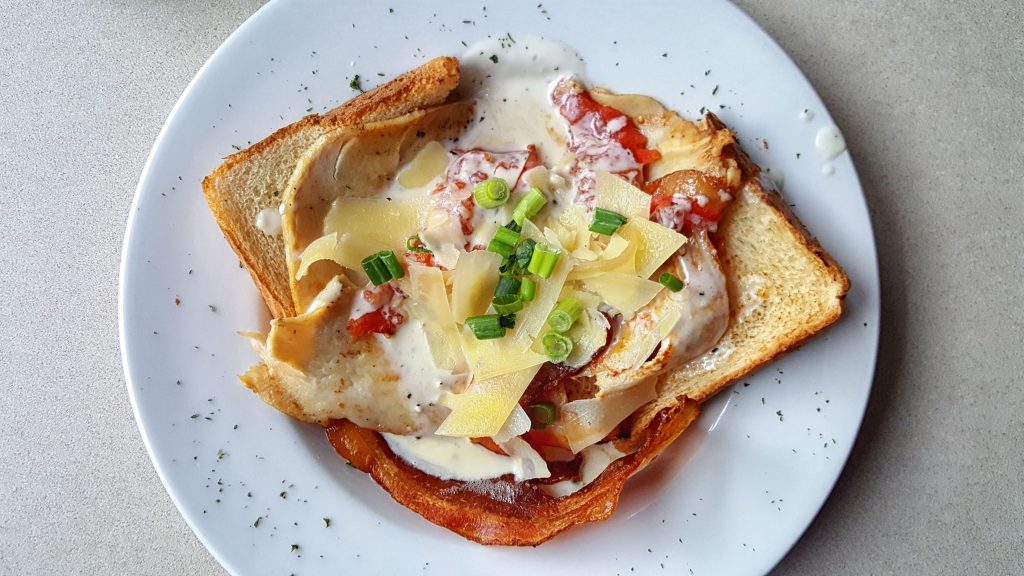
There’s also the Prosperity Sandwich of St. Louis, which we wrote about just two years ago.
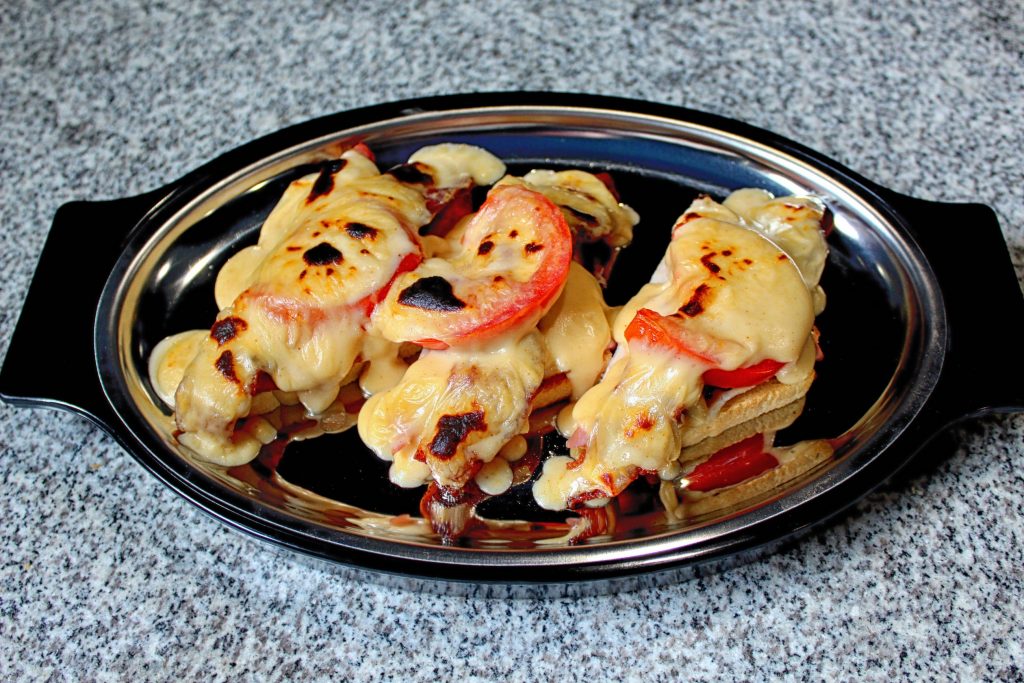
Additionally, there’s a sandwich called Turkey Devonshire that’s local to Pittsburgh, Pennsylvania, which we haven’t covered yet, but is coming up for us sooner or later. It appears to be a near-exact copy of the Hot Brown.
The Cheese Dream is said to have been a favorite during the Great Depression. All three of these other regional American sandwiches are said to have originated near that period–the Hot Brown and Prosperity sandwiches during the 1920s, and the Turkey Devonshire in 1934. Could it be that the Cheese Dream was a missing link?
As it turns out, no. The oldest recipes I could find for the cheese dream did not describe an open-faced sandwich of the type James Beard evangelized. The earliest recipe I’ve located is from the 1916 book “Sandwiches, Salads, and Chafing Dish Recipes” by Marion H. Neil, previously referenced on this very site.
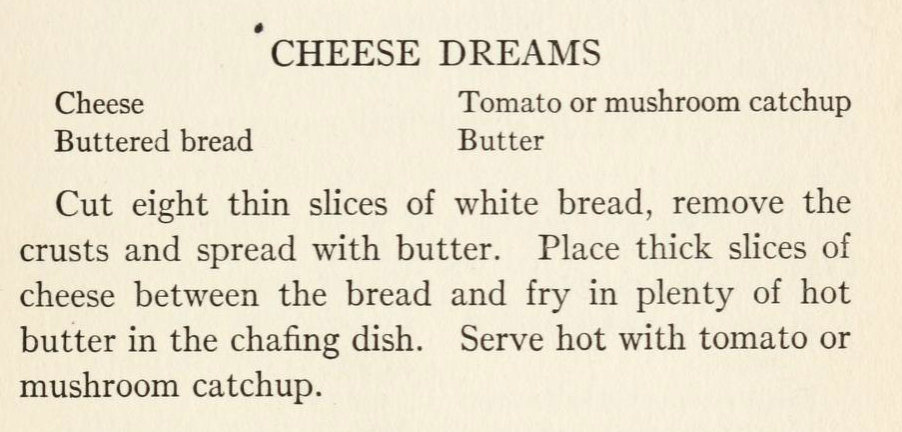
The instructions sound very much like cooking a plain old grilled cheese sandwich, do they not? With, of course, the dainty addition of cutting off the crusts. I found myself intrigued, though, by the instructions to serve hot with “tomato or mushroom catchup.”
Mushroom ketchup is a thing?
It is, in fact–so is banana ketchup in fact, and a number of other historical and emerging varieties including walnut ketchup and mango ketchup. Though mushroom ketchup is less common these days than it was apparently in 1916, there appears to be at least one commercial brand still being sold. As it was out of stock everywhere I looked, I resolved to make my own. I found a recipe on The Spruce Eats, a site I’ve found to be generally reliable in the past, and made a batch of mushroom ketchup that filled 2.5 pint jars.
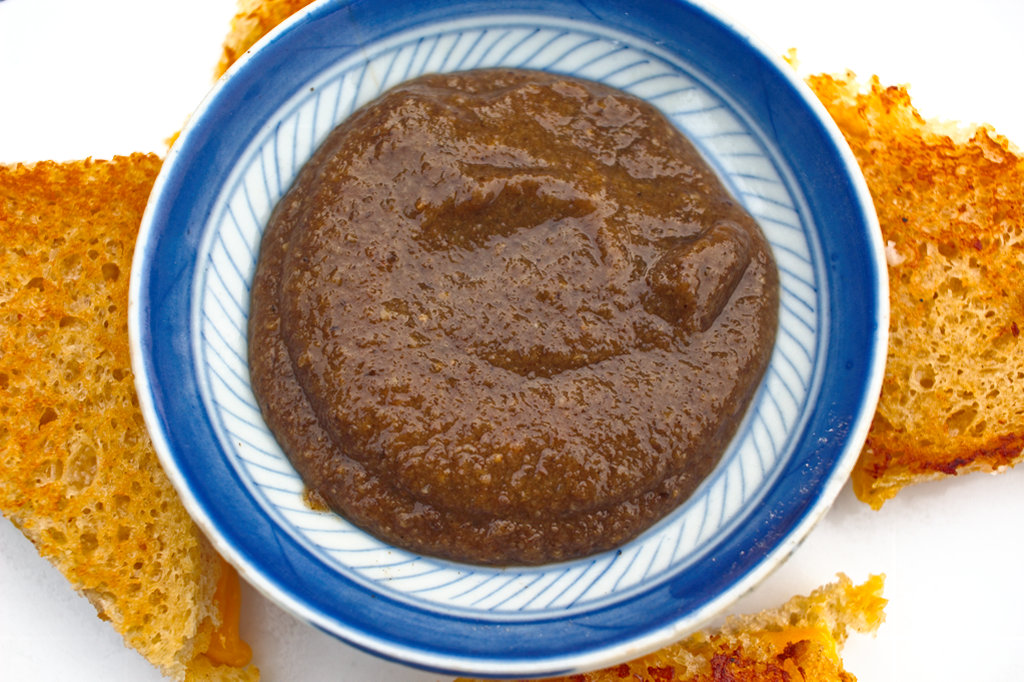
The mushroom ketchup is a deep rich brown in color. In flavor, it is still quite young and vinegary–the instructions say to let it mellow for a few weeks before tasting, a luxury I didn’t have when making these sandwiches–but it wouldn’t be unwelcome to a fan of, say, A1 sauce. There’s a earthy and somewhat funky flavor from the brief fermentation the mushrooms are given, and warm aromatic notes from the spices flavoring it–mace, clove, allspice, ginger. I do not currently have a working blender, and I was unable to process it to quite as smooth a consistency as I’d have liked in my food processor, but I’ll find ways to use this all up over the next few months, I’m sure.
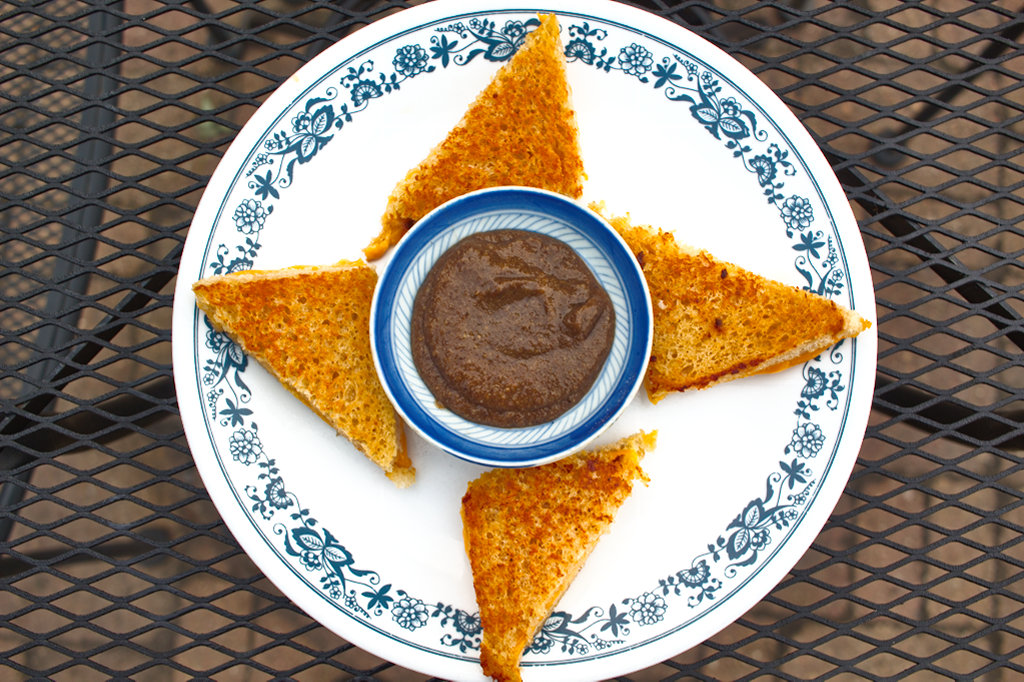
So I made the cheese dream sandwiches per Marion H. Neil and served them with the mushroom ketchup. The bread was a home-baked Pullman loaf, and the cheese was Land-O-Lakes “Sharp Cheddar” American cheese, an absolute stunner of an American cheese, tons of flavor, a texture closer to real cheese than to wax or plastic, but still melts well if you apply enough heat.
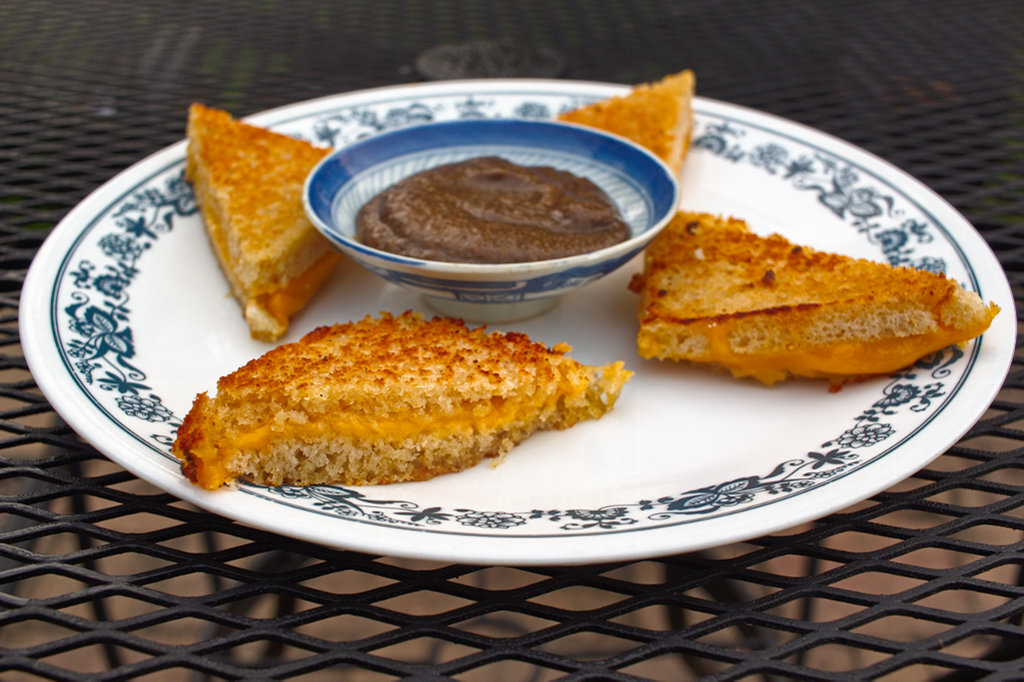
As hoped, the mushroom ketchup was an excellent accompaniment for the cheese sandwiches, savory and warm but with an acidic bite to counter the fattiness of the cheese and butter.
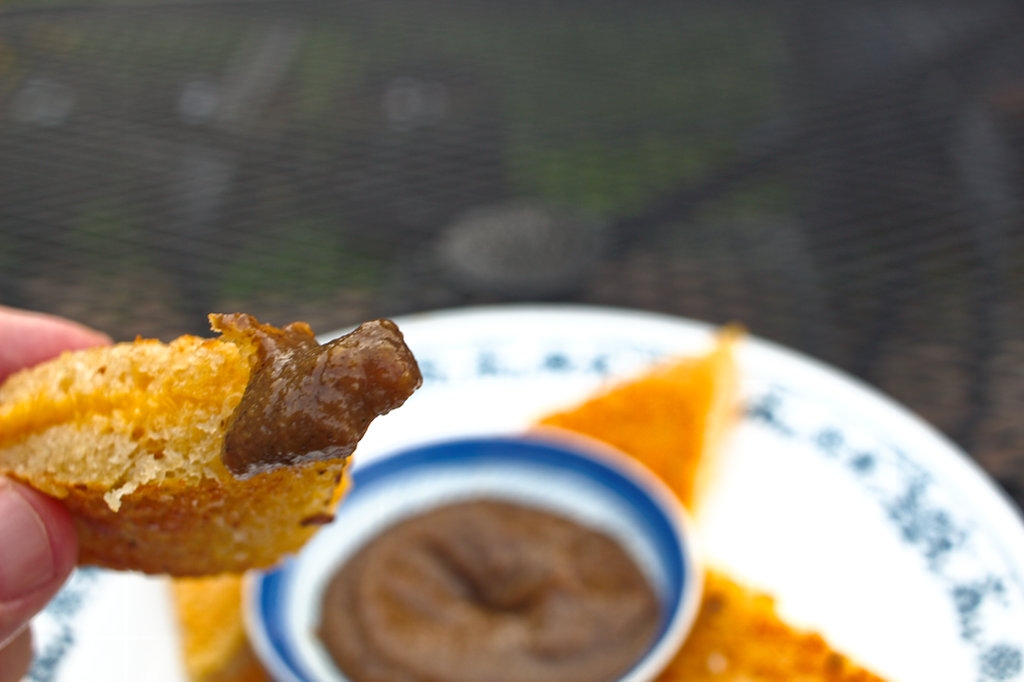
A 1922 issue of Good Housekeeping magazine–the Wikipedia article on cheese dreams says 1918, so this may have been reprinted, but this is the one I found–refers to “our tried and true tea-house friend” the cheese dream sandwich and provides a recipe that also amounts to a very basic grilled cheese sandwich
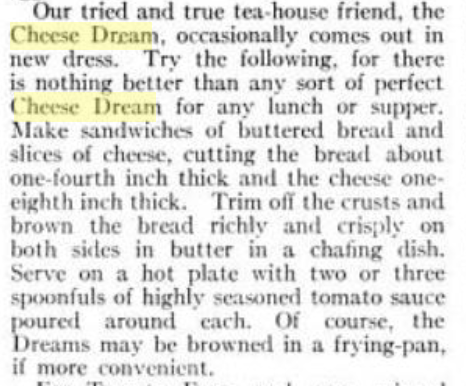
Rather than ketchup, the Good Housekeeping recipe instructs the cook to serve the sandwiches with “two or three spoonfuls of highly seasoned tomato sauce.” As it happens, it is the time of year in which both tomatoes and chili peppers abound in my garden. I cut up a few tomatoes and a single long thin red chili along with some garlic, shallot, paprika, and a few other spices to make a “highly seasoned” tomato sauce to serve this version with.
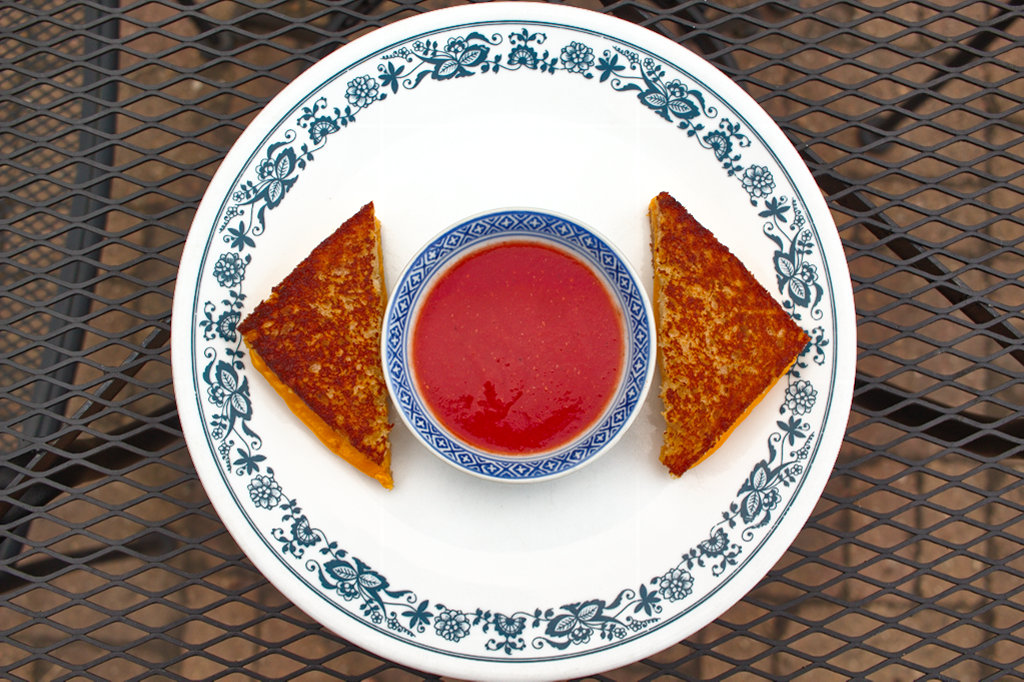
Americans–possibly other nationalities as well but certainly Americans–know what an incredible partner the grilled cheese sandwich has in tomato soup. I may occasionally eat a grilled cheese sandwich without it, but when we are planning on grilled cheese sandwiches for a meal, tomato soup is de rigueur. I usually season my tomato soup with a healthy kick of Louisiana hot sauce. This tomato sauce is something like a thicker, more intense version of that. In other ways, it’s nothing like that at all.
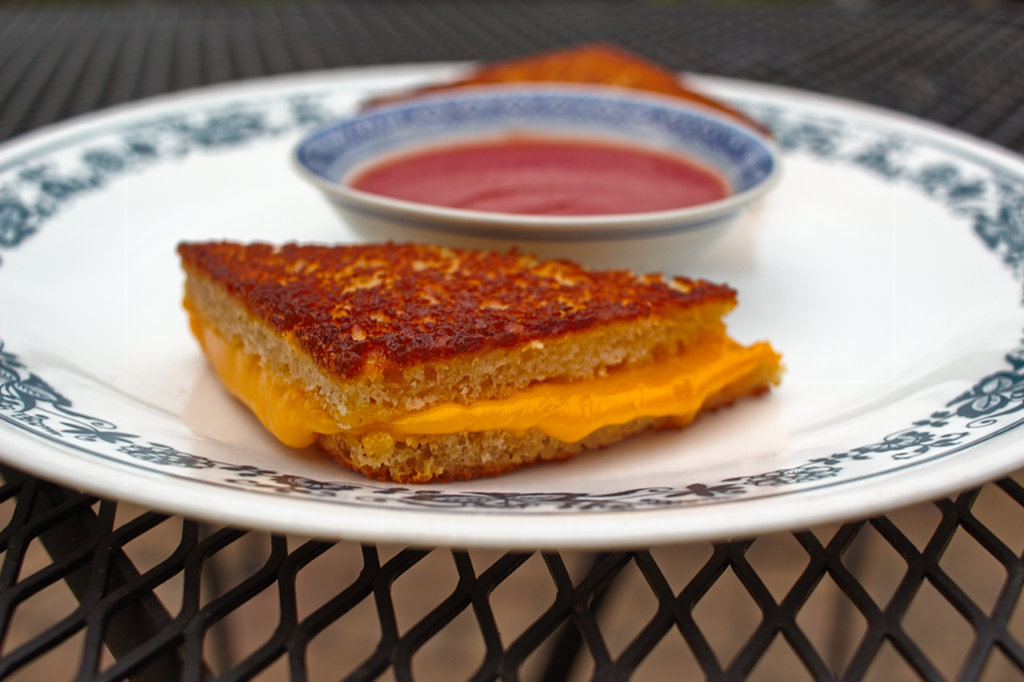
As before, I’ve used my homemade Pullman loaf and the Land O Lakes cheese, which you can see here is as good a melter as any American cheese. The sharp, salty flavor of the cheese, the crisp buttery texture of the bread, and the spicy, umami-rich flavor of the tomato sauce are a simple and perfect combination.
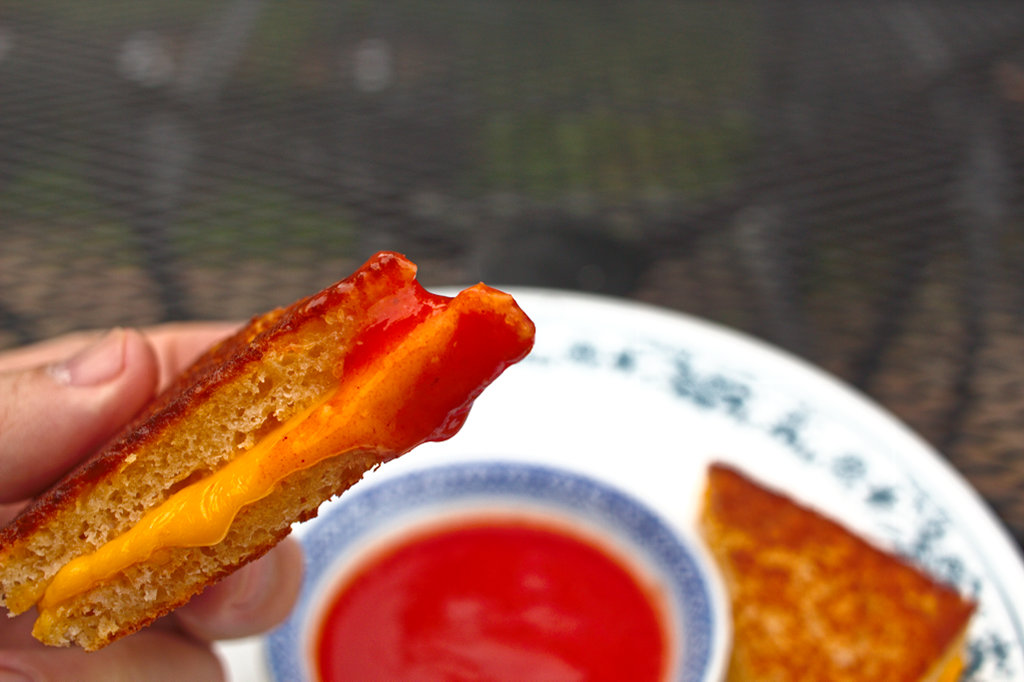
The next-oldest historical recipe for a Cheese Dream sandwich I was able to find, from 1929–we have arrived at the Depression, folks!–followed the same predictable pattern. The book it was published in is the cumbersomely-named “The international cook book; totally different and complete with suggested menus, rules for proper table service, an abundance of practical recipes for every need, famous international recipes, all home tested, cookery technique and complete indexing,” a title that is in fact longer than this recipe

Here we have another simple grilled cheese sandwich–crustless is not specified, but by this time it is assumed–this time served with jelly. I have a number of jellies on hand, but I thought the most appropriate might be my homemade peach preserves.
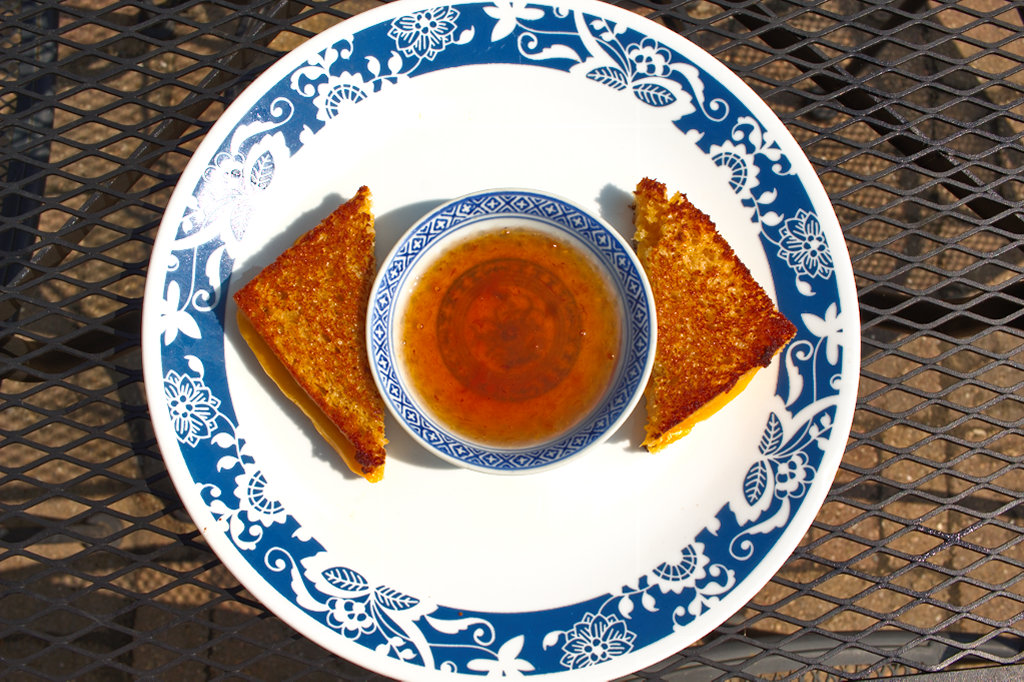
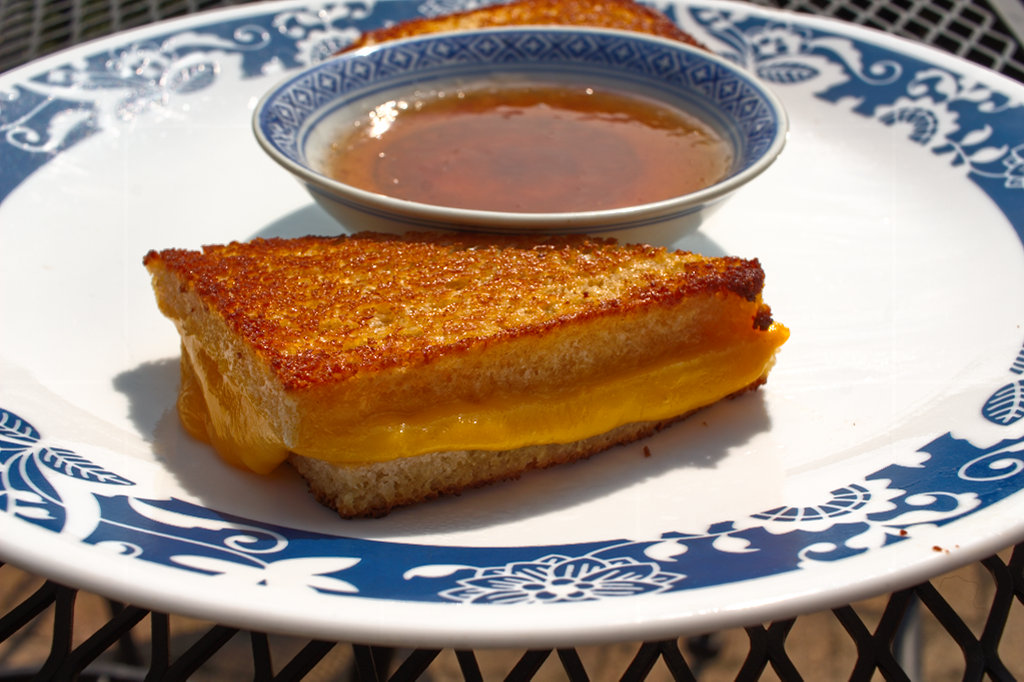
I heated the preserves slightly in the microwave to make them more dippable. Of the three dipping sauces suggested for the cheese dream so far, this was my least favorite. My peach preserves are good, and I don’t have a problem mixing sweet and salty, but I think this would work better if there was ham in the sandwich.
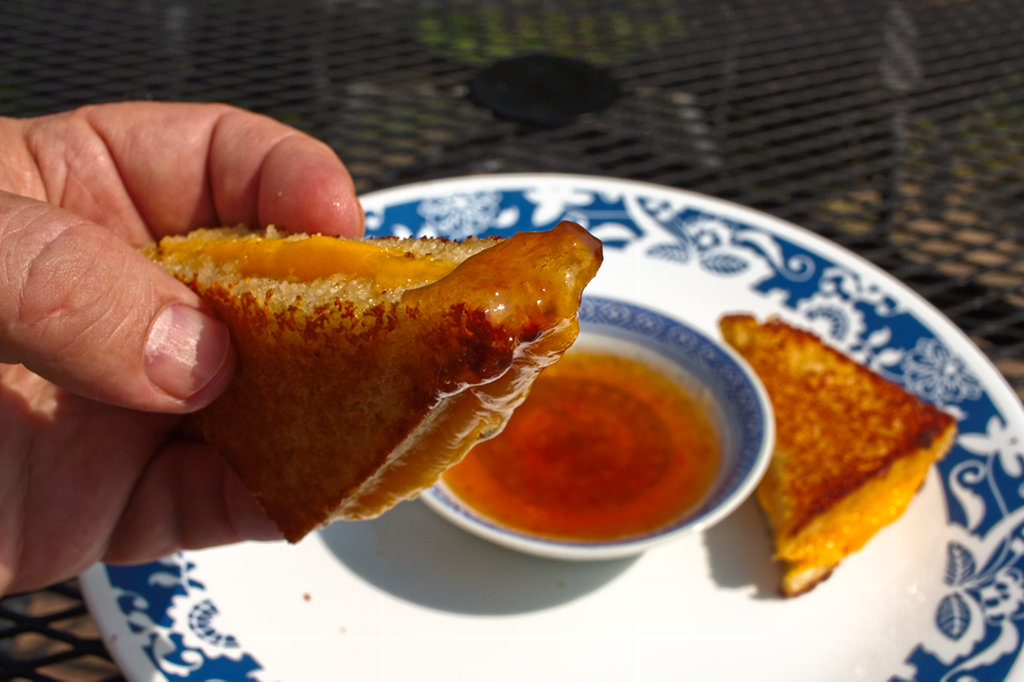
In 1944’s edition of the Good Housekeeping Cook Book, they published a “Cheese Dream Rounds” recipe that finally differs slightly from the pattern seen so far.
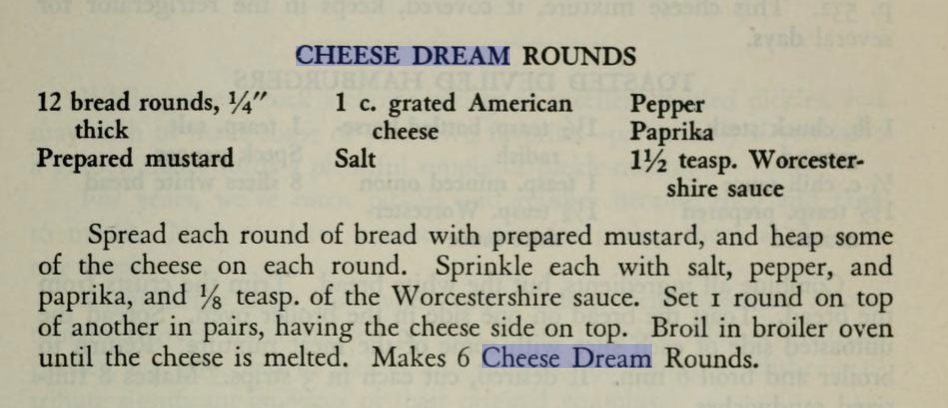
I happen to have the 1949 edition of this book as well, in which they add a variant, the “Ham and Cheese Dream Round” which adds Deviled Ham between the mustard and the cheese.
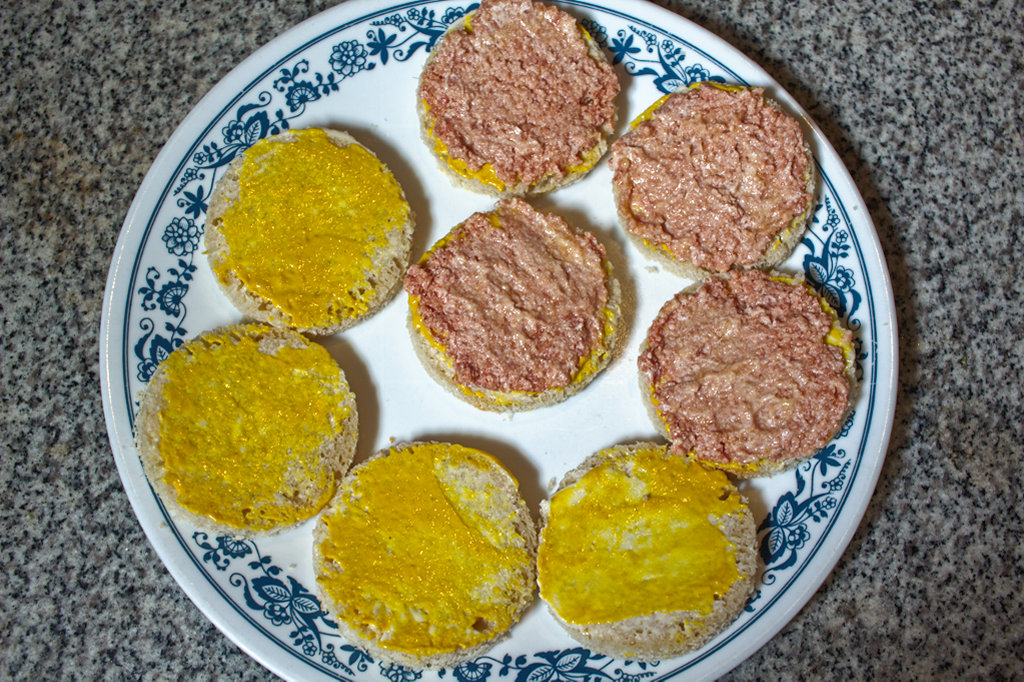
This recipe uses grated cheese, advising to “heap” it onto the bread rounds before seasoning it with Worcestershire sauce, salt, black pepper, and paprika. The version using deviled ham omits the salt.
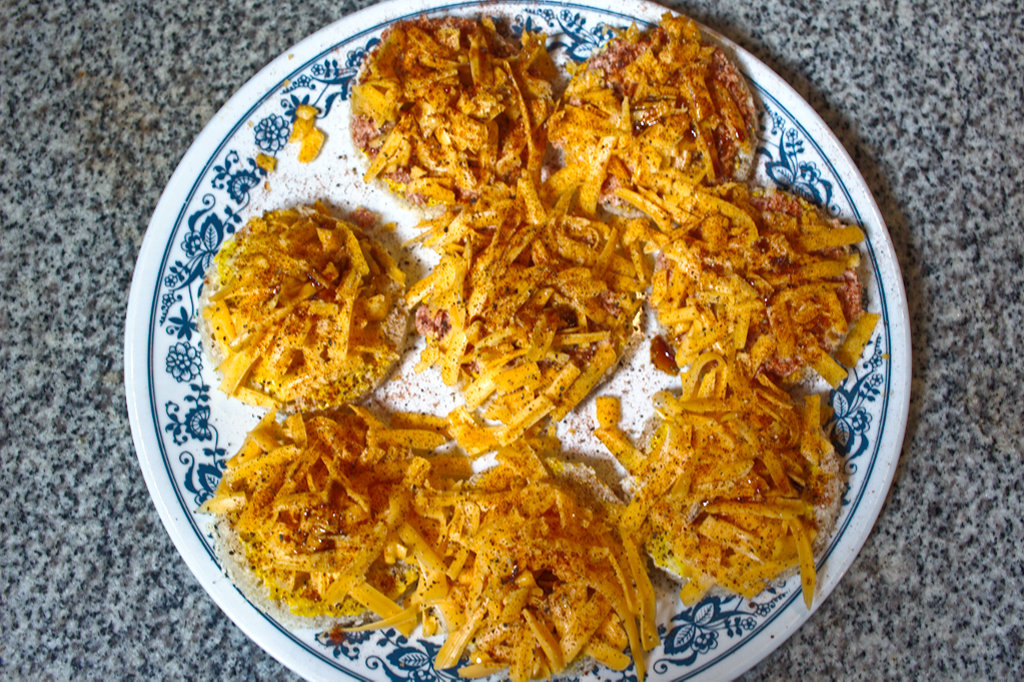
These rounds are then stacked in twos and broiled long enough to melt/brown the cheese.
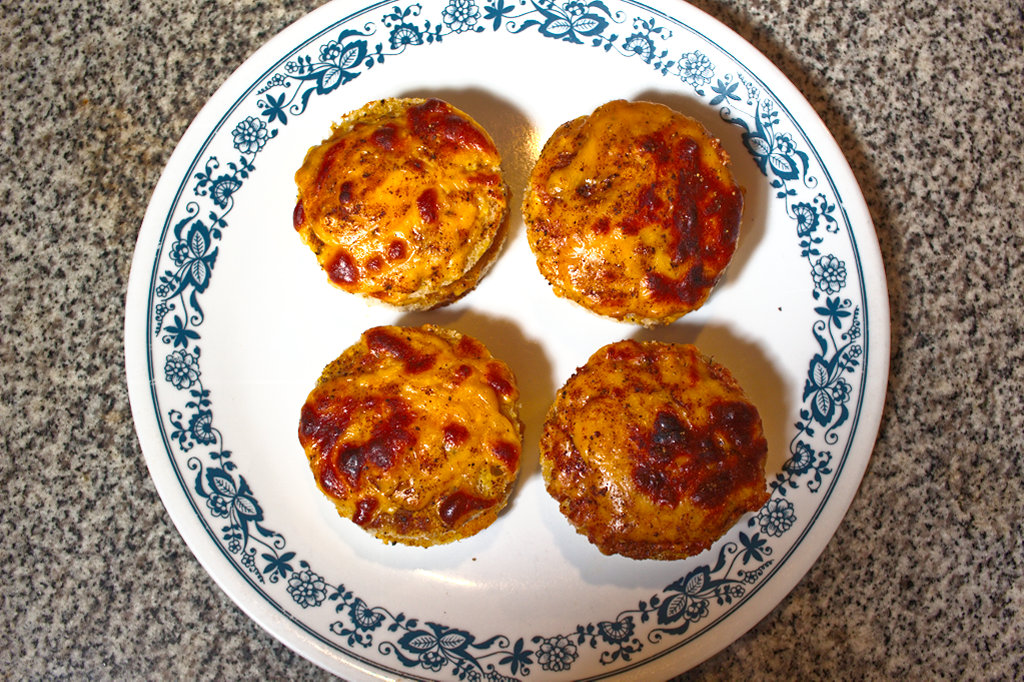
They are… not terrific. The bread is limp and the middle layer of cheese doesn’t have enough time to fully melt before the top layer is close to burning.

Cheese Dream cross section 
Ham and cheese dream cross section
They look pretty though
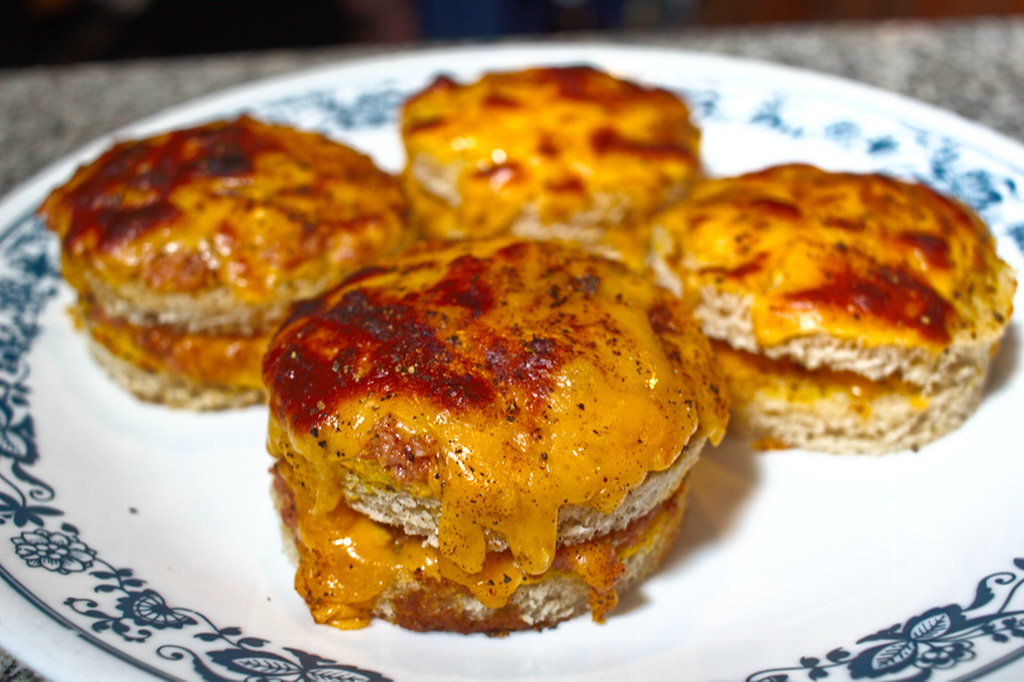
In my archive search of old cookbooks, it isn’t until 1947 that I found a recipe that resembled the Cheese Dream as described by James Beard.
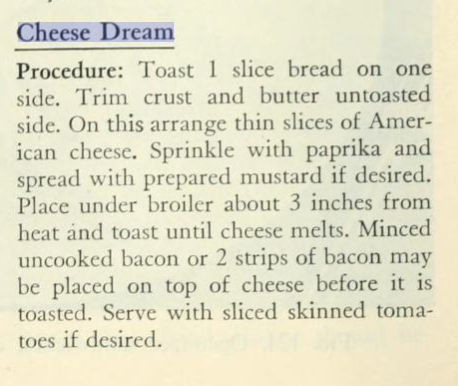
According to this recipe, first we toast a slice of bread on one side only. My assumption is that not only does this give the Cheese Dream some needed texture, it provides a rigidity that makes removing the crusts easier. Then the untoasted side is buttered, spread with a thin little swipe of mustard, dusted with paprika, and topped with a slice of American cheese before being broiled.
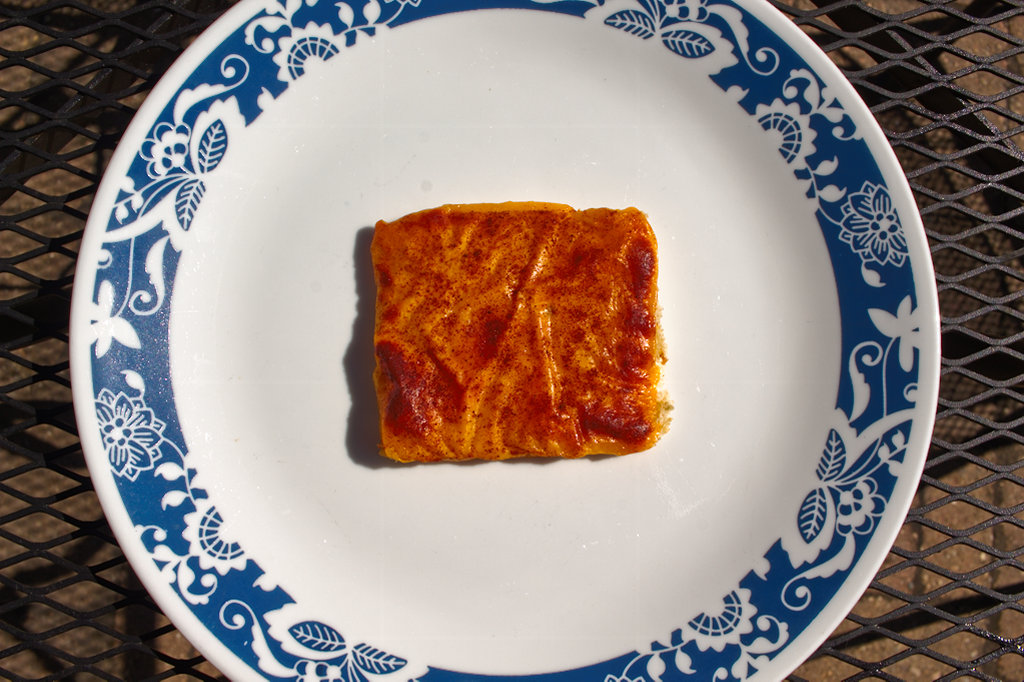
It’s not bad! Mustard is a good condiment for a cheese sandwich; the pungence and acidity of the mustard cuts the fattiness of the cheese, though it also adds some salt, boosting the already-salty American cheese.
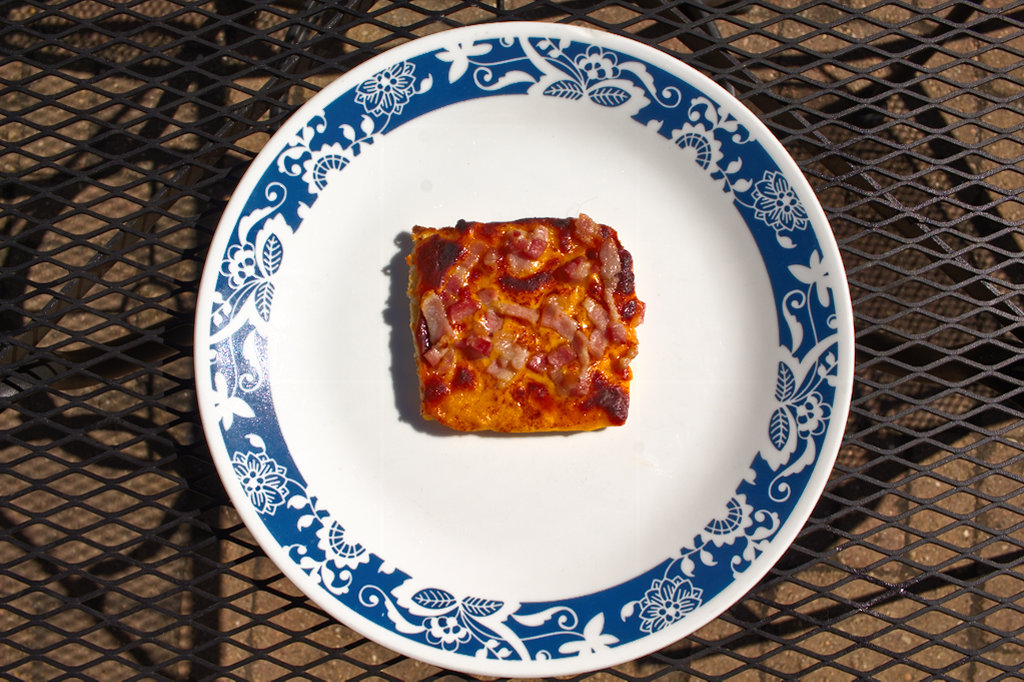
Alternatively, the recipe allows for adding minced raw bacon before broiling, presumably in the hope that the bacon will cook before the cheese burns. The bacon does not cook before the cheese burns, at least not to anything resembling the crisp delightful texture of bacon that has been cooked properly.
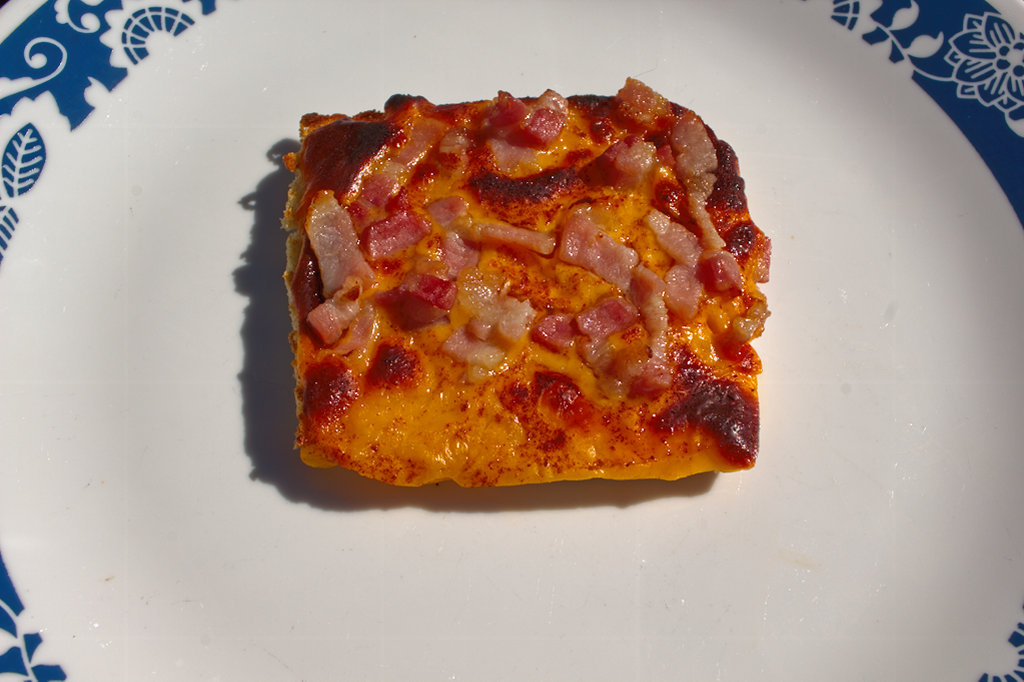
Finally, the recipe gives the option of adding cooked whole slices of bacon to the sandwich before broiling.
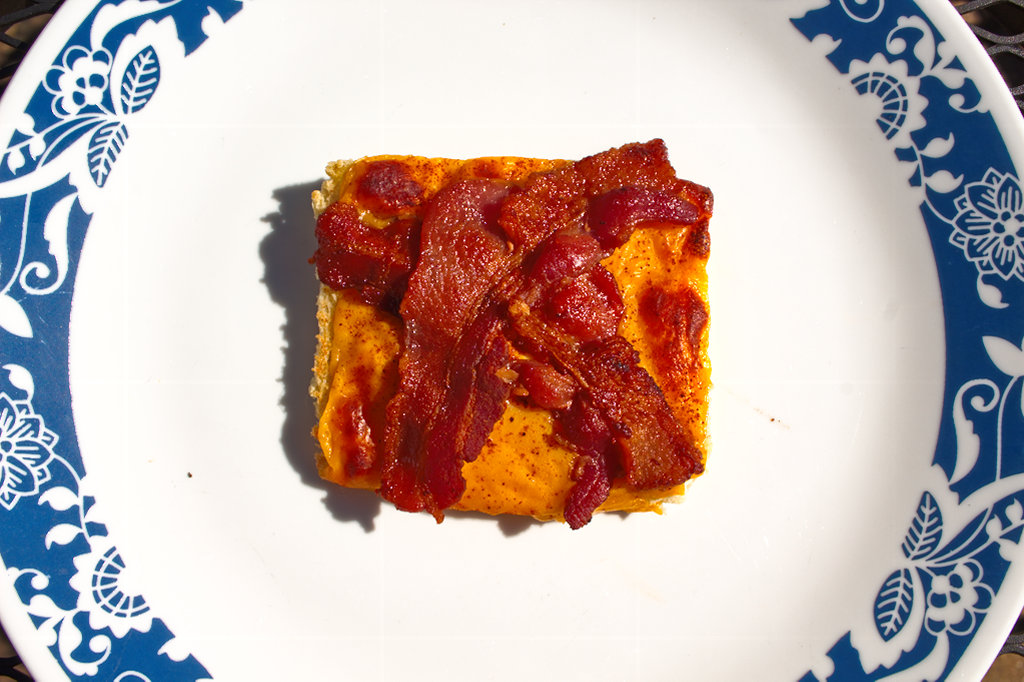
It also allows for the possibility of serving the sandwich with sliced tomato.
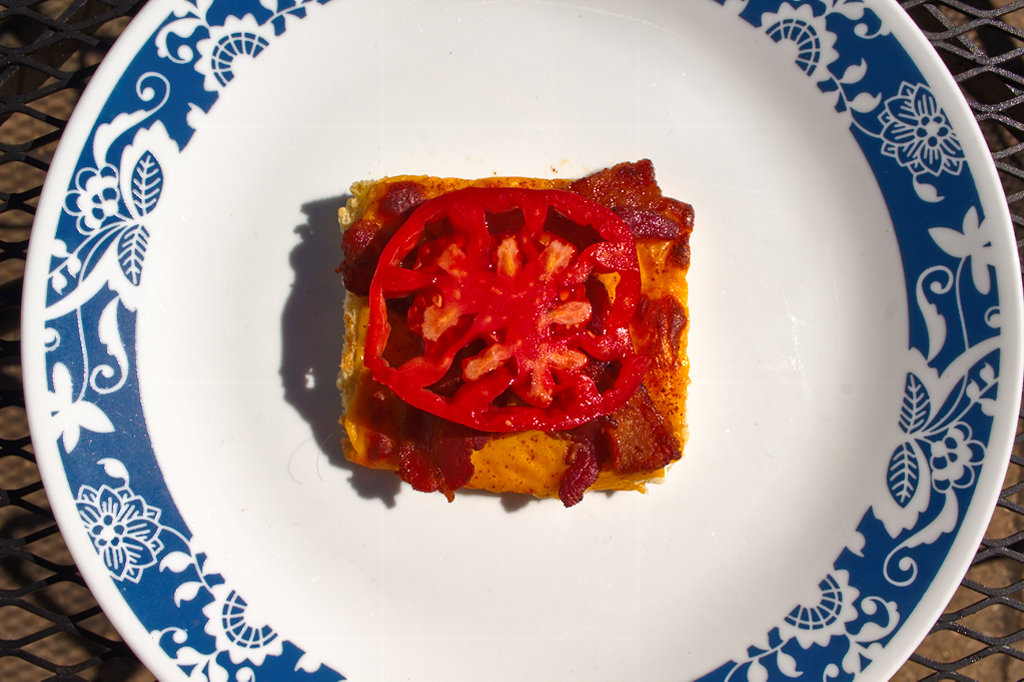
As time goes on from there, the Cheese Dream appears to be a fairly fixed point, a type of cheese toast. It occasionally makes its way into other recipes, such as a 1972 Family Circle cookbook recipe using the simple broiled cheese dreams as a base for hamburgers, or gets remixed, as in a “redreamed” version using bacon, slaw, and Gruyere cheese on rye English muffins from Food & Wine magazine in 1990, or the version eschewing bacon in favor of pickled beets in a 1996 vegetarian cookbook.

Family circle illustrated library of cooking; your ready reference for a lifetime of good eating by Family Circle. 1972. Page 336 
The Best of Food & wine : [1990 collection] by American Express Publishing Corporation. 1990. Page 158 
The vegetarian table by Deborah Madison. 1996. Page 60.
They all sound delightful; yes, even the vegetarian version. I happen to have a terrific jar of pickled beets still in my pantry. I think my ideal version, though, would hew closer to the James Beard vision. Rather than put the tomato under the cheese, though, I’d have it on top, so it gets the benefit of the broiling. I’m surprised James Beard didn’t serve it this way: I’ve read the phrase “broiled tomatoes” in his writing more than in any other source.
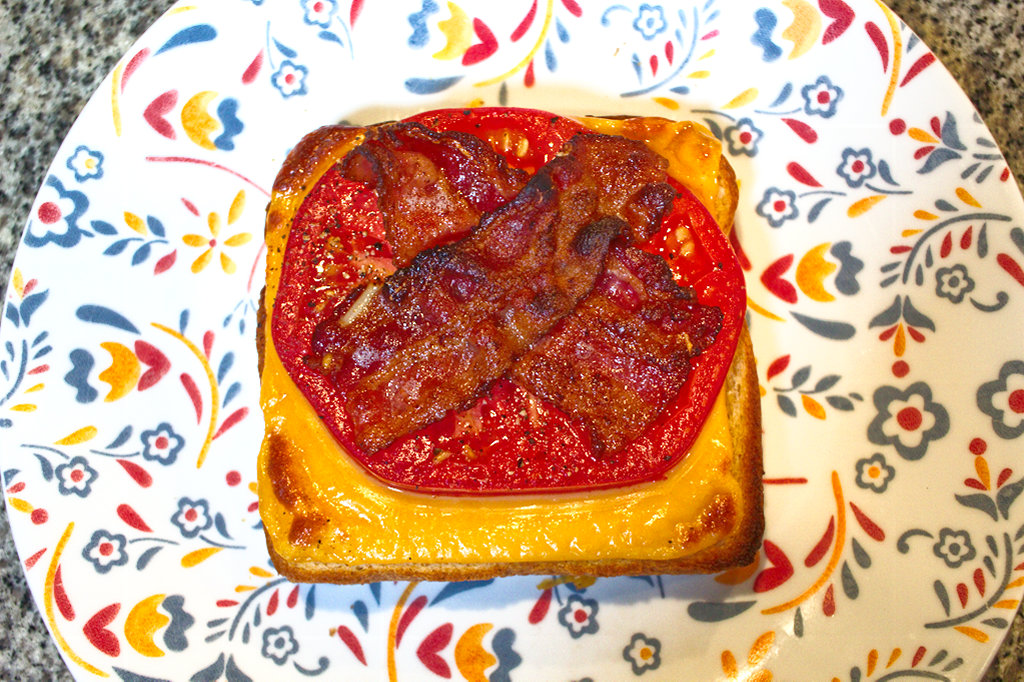
This sandwich is an umami overload. Tomatoes are one of the most savory ingredients available, containing both glutamate and nucleotide sources of umami. Cheese and bacon are both umami powerhouses as well. This lingering, mouthfilling flavor is augmented by a slight sweetness from this utterly perfect tomato from my garden, and a crisp butteriness from this completely ordinary, lightly-toasted white bread. Would it be improved by a better bread? Maybe just a touch. But the bread isn’t really the point here.
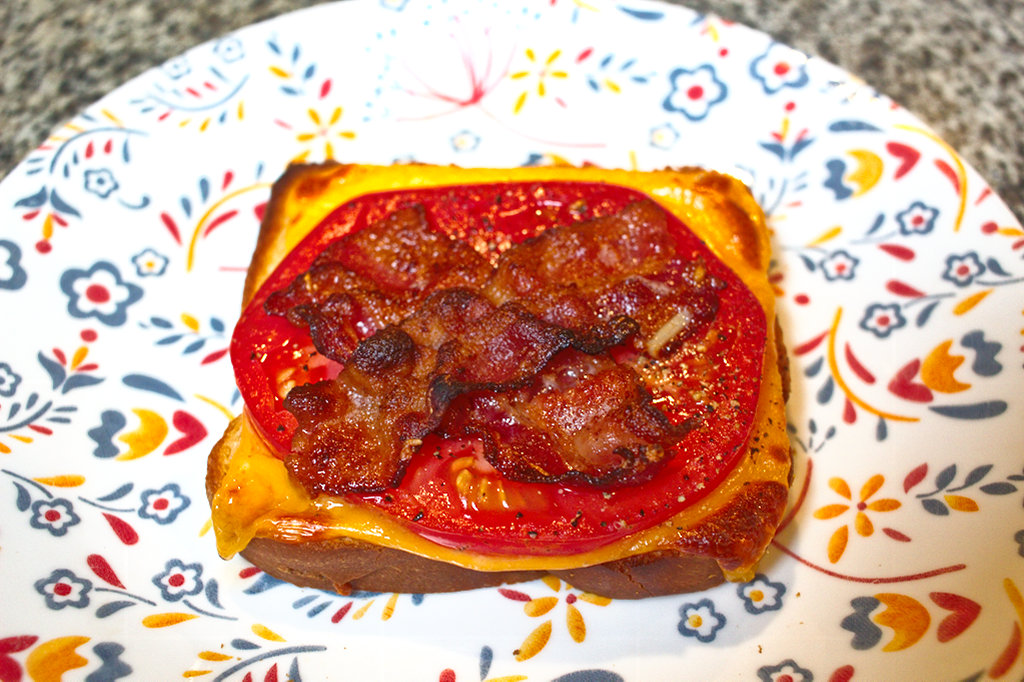
Crisp bacon. Rich tomato. Sharp, melty cheese. These are the hallmarks of the James Beard-style Cheese Dream.
I started this month believing that I’d find a sort of ur-cheese toast that had eventually evolved and branched out into some of the richer open-faced sandwiches of America. Instead, I found a simple grilled cheese sandwich that had evolved by becoming simpler yet, losing the top slice of bread but gaining some tasty garnishes. Whether accompanied by ketchup or tomato soup, Deviled Ham or bacon and broiled tomato, a combination of crisp buttered bread and melted cheese is sure to be a dream.

I like sandwiches.
I like a lot of other things too but sandwiches are pretty great


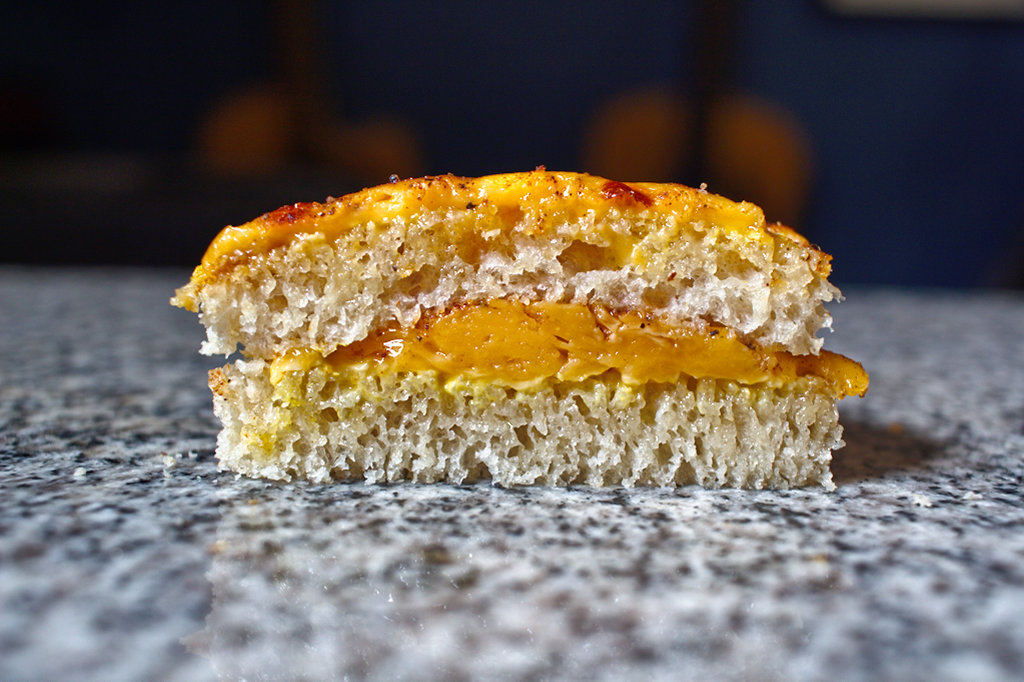
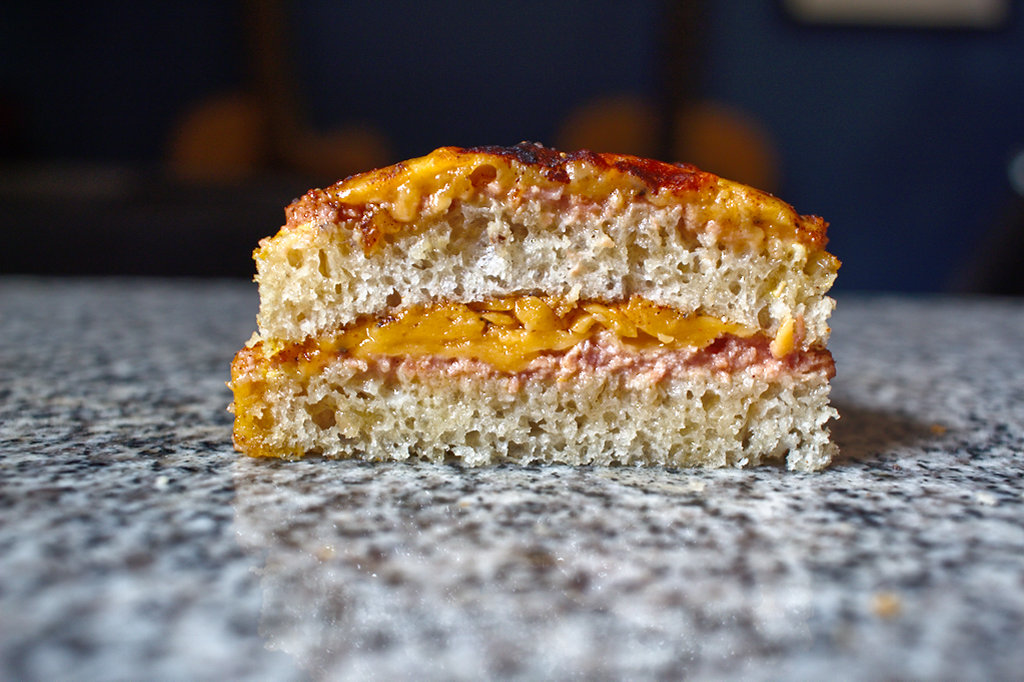
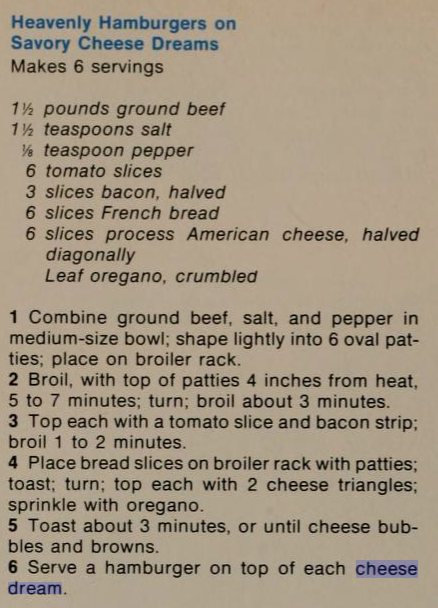
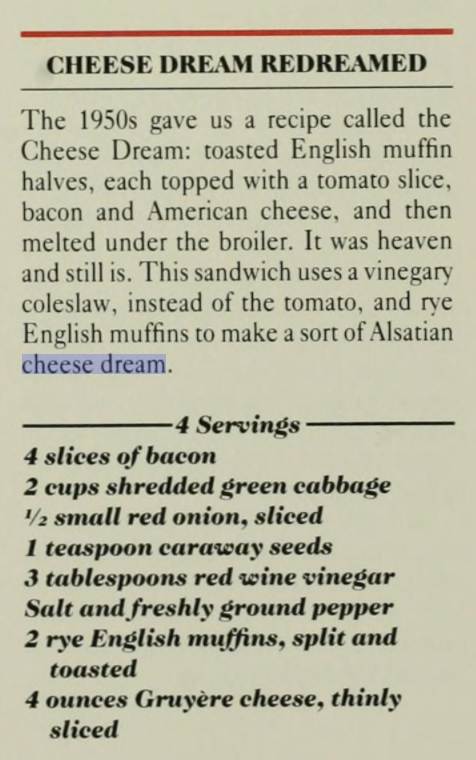
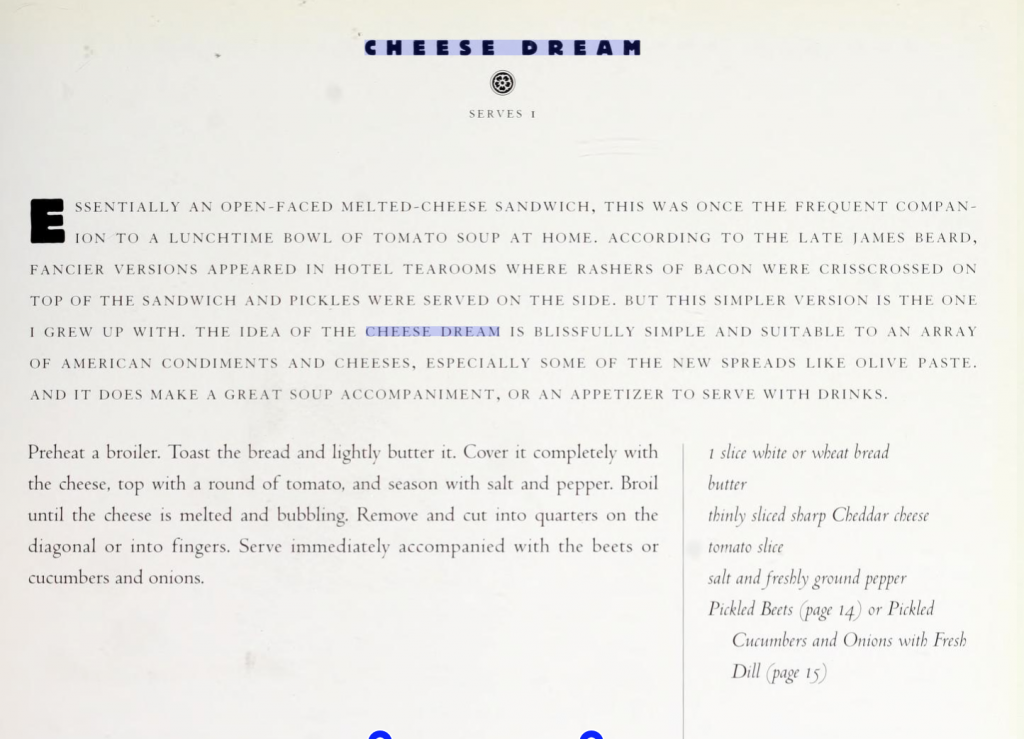
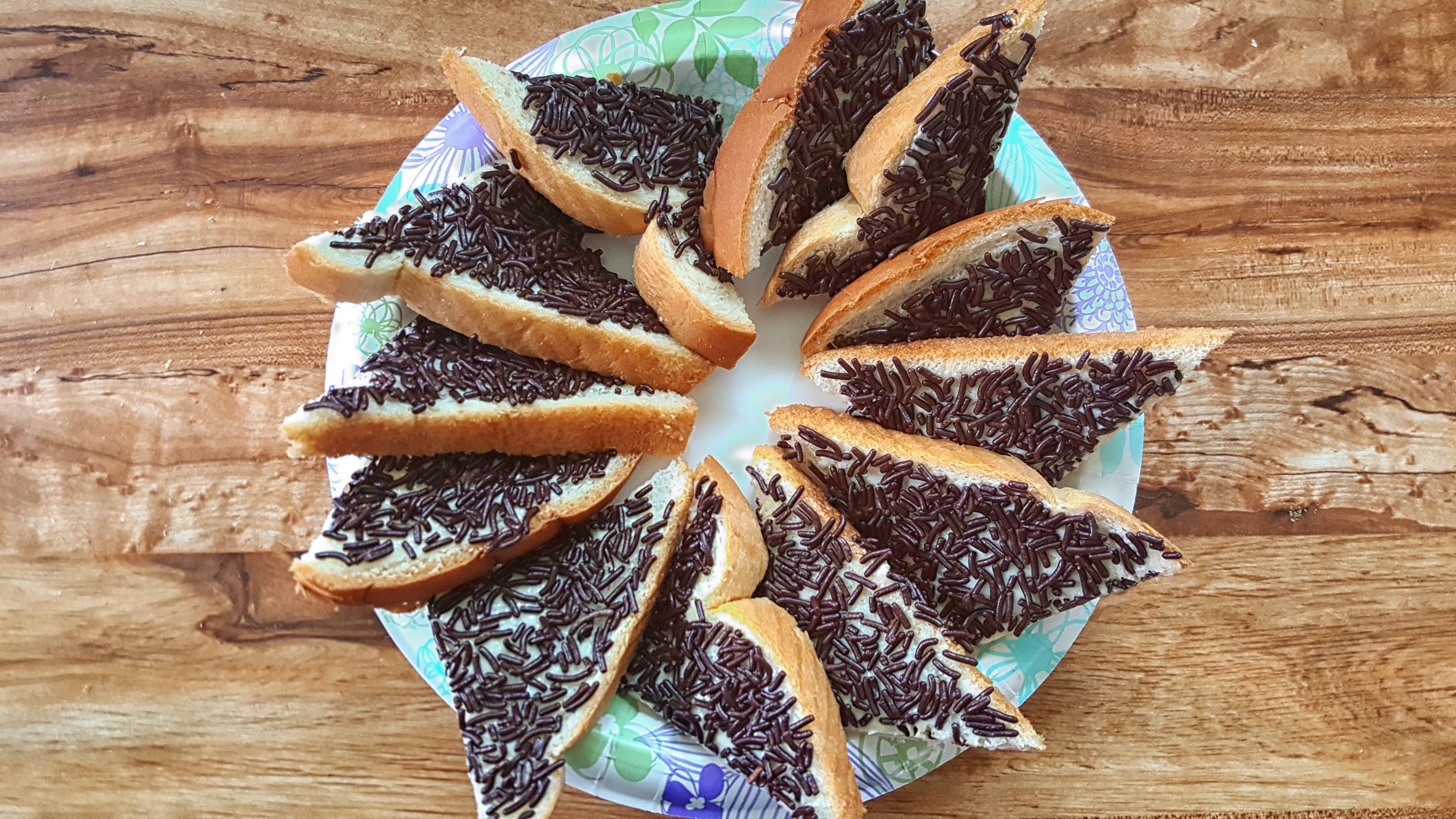

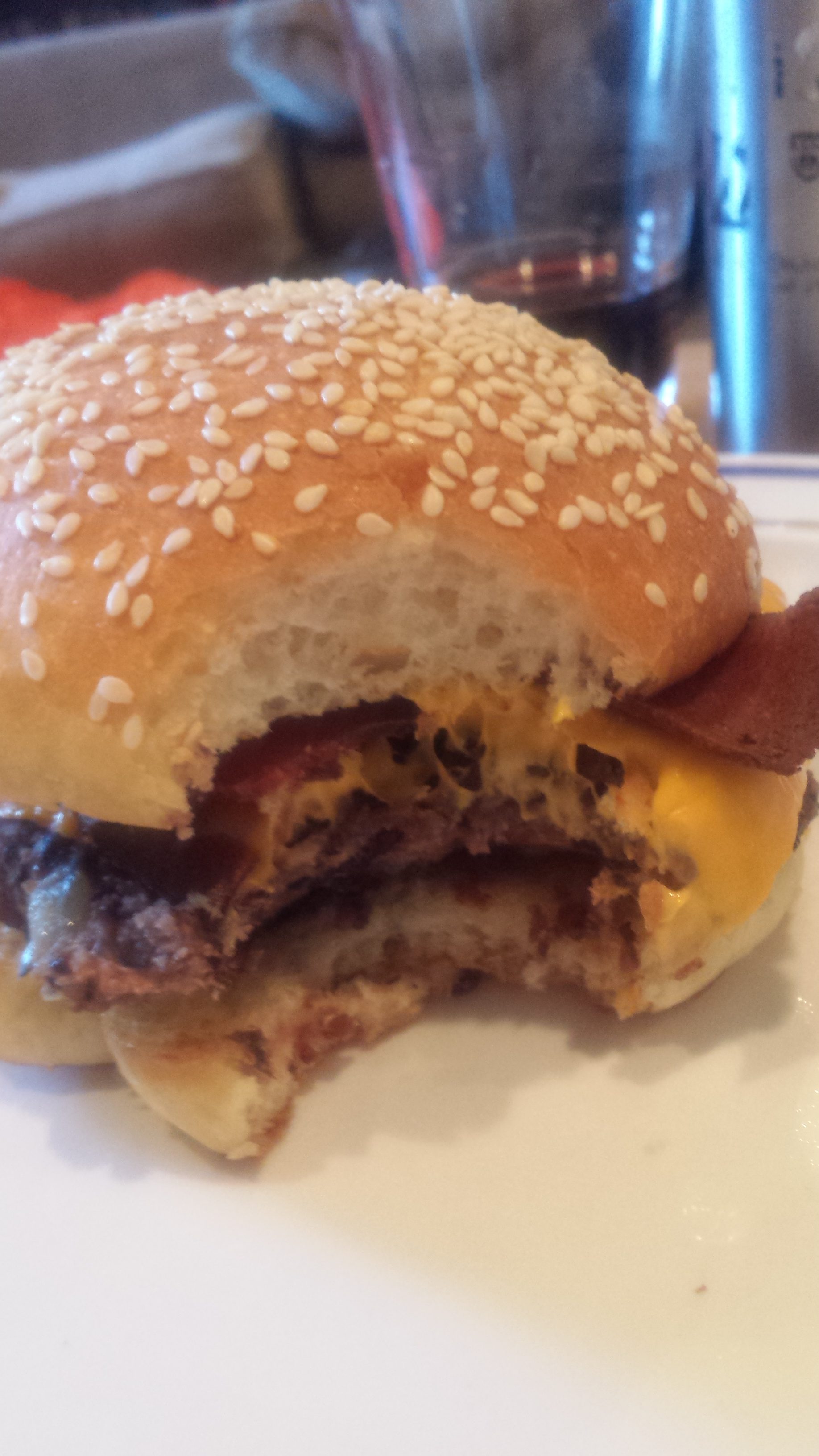






Recent Comments